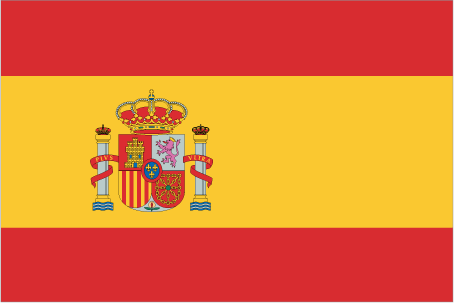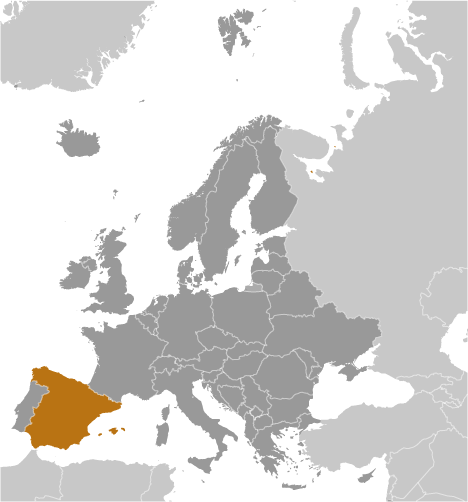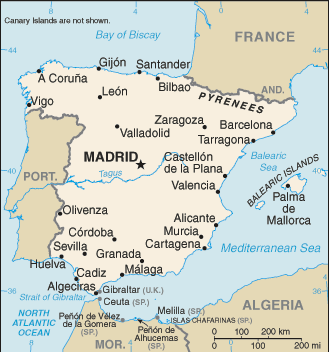
|
|
Advertisements:
GeographyLocation
Southwestern Europe, bordering the Mediterranean Sea, North Atlantic Ocean, Bay of Biscay, and Pyrenees Mountains; southwest of France Geographic coordinates
40 00 N, 4 00 W
Map references
Europe
Area World Ranking: 52
Total 505,370 sq km
Land 498,980 sq km Water 6,390 sq km Note There are two autonomous cities - Ceuta and Melilla - and 17 autonomous communities including Balearic Islands and Canary Islands, and three small Spanish possessions off the coast of Morocco - Islas Chafarinas, Penon de Alhucemas, and Penon de Velez de la Gomera Area - comparative
Slightly more than twice the size of Oregon Land boundaries
Total 1,917.8 km
Border countries Andorra 63.7 km, France 623 km, Gibraltar 1.2 km, Portugal 1,214 km, Morocco (Ceuta) 6.3 km, Morocco (Melilla) 9.6 km Coastline
4,964 km
Maritime claims
Territorial sea 12 nm
Contiguous zone 24 nm Exclusive economic zone 200 nm (applies only to the Atlantic Ocean) Climate
Temperate; clear, hot summers in interior, more moderate and cloudy along coast; cloudy, cold winters in interior, partly cloudy and cool along coast Terrain
Large, flat to dissected plateau surrounded by rugged hills; Pyrenees Mountains in north Elevation extremes
Lowest point Atlantic Ocean 0 m
Highest point Pico de Teide (Tenerife) on Canary Islands 3,718 m Natural resources
Coal, lignite, iron ore, copper, lead, zinc, uranium, tungsten, mercury, pyrites, magnesite, fluorspar, gypsum, sepiolite, kaolin, potash, hydropower, arable land Land use
Arable land 27.18%
Permanent crops 9.85% Other 62.97% (2005) Irrigated land
38,000 sq km (2003)
Total renewable water resources
111.1 cu km (2005)
Freshwater withdrawal (domestic/industrial/agricultural)
Total 37.22 cu km/yr (13%/19%/68%)
Per capita 864 cu m/yr (2002) Natural hazards
Periodic droughts, occasional flooding Volcanism Volcanic activity in the Canary Islands, located off Africa's northwest coast; Teide (elev. 3,715 m) has been deemed a "Decade Volcano" by the International Association of Volcanology and Chemistry of the Earth's Interior, worthy of study due to its explosive history and close proximity to human populations; La Palma (elev. 2,426 m), which last erupted in 1971, is the most active of the Canary Islands volcanoes; Lanzarote is the only other historically active volcano Environment - current issues
Pollution of the Mediterranean Sea from raw sewage and effluents from the offshore production of oil and gas; water quality and quantity nationwide; air pollution; deforestation; desertification Environment - international agreements
Party to
Air Pollution, Air Pollution-Nitrogen Oxides, Air Pollution-Sulfur 94, Air Pollution-Volatile Organic Compounds, Antarctic-Environmental Protocol, Antarctic-Marine Living Resources, Antarctic Treaty, Biodiversity, Climate Change, Climate Change-Kyoto Protocol, Desertification, Endangered Species, Environmental Modification, Hazardous Wastes, Law of the Sea, Marine Dumping, Marine Life Conservation, Ozone Layer Protection, Ship Pollution, Tropical Timber 83, Tropical Timber 94, Wetlands, Whaling Signed, but not ratified Air Pollution-Persistent Organic Pollutants Geography - note
Strategic location along approaches to Strait of Gibraltar; Spain controls a number of territories in northern Morocco including the enclaves of Ceuta and Melilla, and the islands of Penon de Velez de la Gomera, Penon de Alhucemas, and Islas Chafarinas
Comments
Add a new comment: |
Advertisement
Members area
Spain (Madrid):
 
GPS points from Spain (Madrid)
|
||||||||

 Spain's powerful world empire of the 16th and 17th centuries ultimately yielded command of the seas to England. Subsequent failure to embrace the mercantile and industrial revolutions caused the country to fall behind Britain, France, and Germany in economic and political power. Spain remained neutral in World Wars I and II but suffered through a devastating civil war (1936-39). A peaceful transition to democracy following the death of dictator Francisco FRANCO in 1975, and rapid economic modernization (Spain joined the EU in 1986) gave Spain a dynamic and rapidly growing economy and made it a global champion of freedom and human rights. The government's major focus for the immediate future will be on measures to reverse the severe economic recession that started in mid-2008.
Spain's powerful world empire of the 16th and 17th centuries ultimately yielded command of the seas to England. Subsequent failure to embrace the mercantile and industrial revolutions caused the country to fall behind Britain, France, and Germany in economic and political power. Spain remained neutral in World Wars I and II but suffered through a devastating civil war (1936-39). A peaceful transition to democracy following the death of dictator Francisco FRANCO in 1975, and rapid economic modernization (Spain joined the EU in 1986) gave Spain a dynamic and rapidly growing economy and made it a global champion of freedom and human rights. The government's major focus for the immediate future will be on measures to reverse the severe economic recession that started in mid-2008.